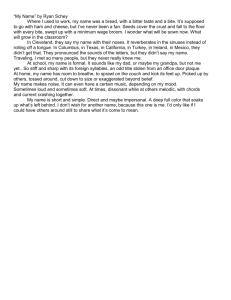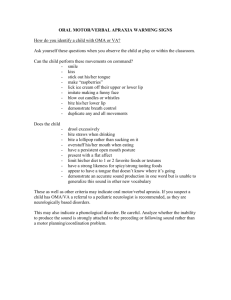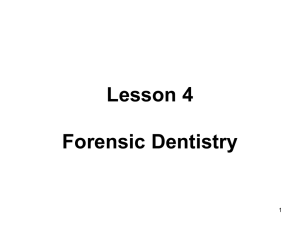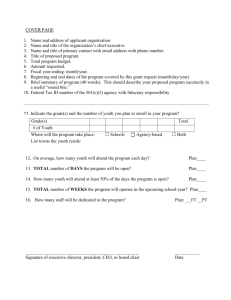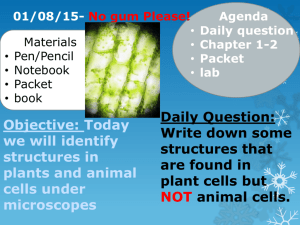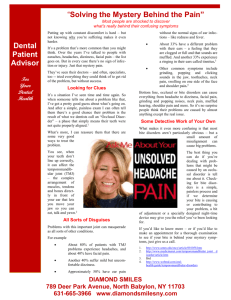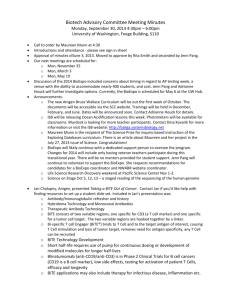Forensic Odontology
advertisement
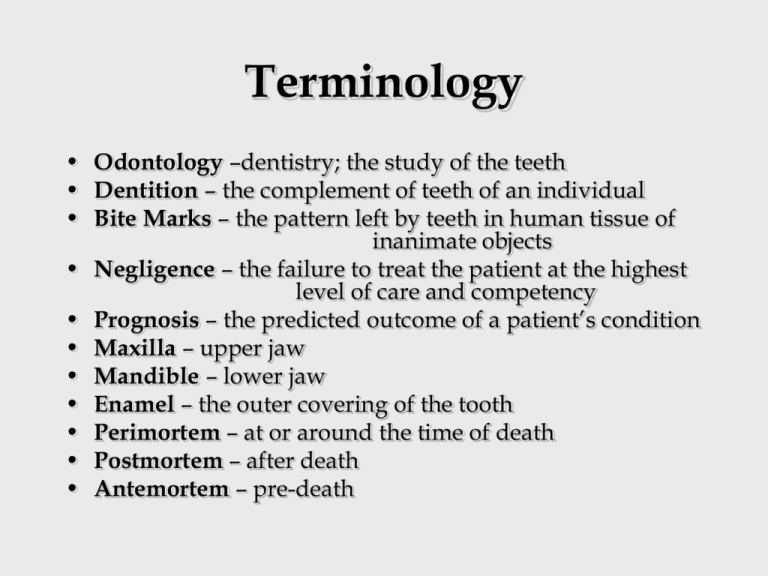
Terminology • Odontology –dentistry; the study of the teeth • Dentition – the complement of teeth of an individual • Bite Marks – the pattern left by teeth in human tissue of inanimate objects • Negligence – the failure to treat the patient at the highest level of care and competency • Prognosis – the predicted outcome of a patient’s condition • Maxilla – upper jaw • Mandible – lower jaw • Enamel – the outer covering of the tooth • Perimortem – at or around the time of death • Postmortem – after death • Antemortem – pre-death Overview • • • • • Introduction History Dental Training Expert Witness Testimony Body Identification • • • • Dentition Descriptions Postmortem Examination and Records Antemortem Record and Examination Record Comparison and Reporting • Bite Mark Analysis • Bite Mark Recognition • Collection and Comparison of Bite Mark Evidence I. Introduction 1. Forensic Odontology is the application of the arts and sciences of dentistry to the legal system. 2. Three (3) main areas: 1. Use of dentition in the identification of individuals by comparing teeth with predeath dental records and the use of teeth as a source for DNA 2. Comparison of dentition with pattern injuries in human tissue or inanimate substances 3. Analysis of negligence, standard of care issues, and injury in malpractice cases. How is Odontology used to Solve Crimes? • http://www.youtube.com/watch?v=D KeEbVLZNWc Body Identification by Dental Means • Dentition Descriptions • Post mortem Examination and Record • Ante mortem record and examination • Record Comparison and reporting • Forensic Dentistry in mass disaster Dentition Descriptions • Every Individual has 2 dentitions in their life: • Primary (20) • Permanent (32) • The teeth are divided between 2 jaws • Maxilla • Mandible • Primary Dentition – A-T • Permanent uses #1-#16 (upper), and #17-#32 lower Structure of the tooth • All teeth are divided into a crown, and a root. • Crown is covered with enamel. • In the center of the tooth is the pulp or nerve tissue----DNA source Post mortem Examination and Record • Begins with access to dentition • May be done in place (in situ) • Dentition may need to be removed • If the jaw is removed, it is first soaked in hydrogen peroxide… • Statements are made whether teeth are erupted, restored, and with what filling material. • Also gum and periodontal disease • X-rayed if possible Ante mortem record and examination • The accuracy and completeness of a persons dental records allow a dentist to make a positive identity with reasonable certainty. • Next of kin • Personal effects • Once a person has gone missing their dental records are entered into a national database Record Comparison and reporting • If the postmortem and ante mortem data are complete, the comparison and identification process is straightforward. • Each tooth of the post mortem record is compared to the same tooth in the ante mortem record. • A statement is made… • • • • No inconsistencies Explainable inconsistencies Unexplainable inconsistencies Undeterminable • The most reliable method is X-rays Forensic Dentistry in Mass Disaster Forensic Dentists face several challenges in Mass Disaster cases: •Dismemberment and alterations of dentition •Victims can be from other countries and obtaining ante mortem records is difficult •The amount of stress in dealing with these situations is debilitating Bite Mark Analysis • Recognition • Most often seen in cases of abuse, rape, murder • In order to be used as evidence: • Recognizable bite pattern • Know what to do with the evidence • The first and second bicuspids are rarely involved in bite marks Bite Mark Recognition….. • Bite marks in human tissue depends on: • The tissue bitten • Muscle or connective tissue has a more distinct outline compared to fatty tissue • The biting force • Defensive or aggressive bite marks tend to be less distinct and may show tearing • The resistance to biting by the victim • The more compliant the victim, the more defined the mark • Bite marks found on deceased victims are more useful than on living victims. • On a living victim is must be collected with in 8 hours Using Bite Marks to Determine Time of Death • 1: Ante mortem bite marks – injury inflicted while the heart is still beating will produce bruising around the patterns and will usually diffuse • 2: Peri mortem Bite marks – (w/in 5 minutes) injury inflicted at the time the heart stops will produce well defined bruising • 3: Postmortem bite marks: the heart is not beating and the blood has coagulated produces well define indents and no bruising 10 days later Collection Of Evidence • Bite marks can only be used as evidence if all data is carefully collected. • Photographed with ruler • Swabbed for saliva and DNA • Impressions are made • Cast of assailants (suspect) teeth • Metric analysis Comparison • The last step in bite mark analysis is the comparison of the bite mark with the suspects dentition. • Saliva is compared (amylase, ABO blood type, DNA) • Bite planes • Photographs • Metric Analysis
